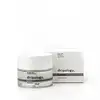What's inside
What's inside
 Key Ingredients
Key Ingredients

 Benefits
Benefits

 Concerns
Concerns

 Ingredients Side-by-side
Ingredients Side-by-side

Aloe Barbadensis Leaf Juice
Skin ConditioningGlyceryl Stearate Se
EmulsifyingCaprylic/Capric Triglyceride
MaskingCetearyl Alcohol
EmollientCoco-Caprylate
EmollientSodium Stearoyl Lactylate
EmulsifyingSorbitan Stearate
EmulsifyingRosa Moschata Seed Oil
EmollientHelianthus Annuus Seed Oil
EmollientArgania Spinosa Kernel Oil
EmollientMacadamia Ternifolia Seed Oil
EmollientOenothera Biennis Oil
EmollientSaccharomyces Ferment Lysate Filtrate
Skin ConditioningAllantoin
Skin ConditioningPanthenol
Skin ConditioningTocopheryl Acetate
AntioxidantDicaprylyl Carbonate
EmollientParfum
MaskingEthylhexylglycerin
Skin ConditioningCitric Acid
BufferingLactic Acid
BufferingWater
Skin ConditioningSodium Benzoate
MaskingPotassium Sorbate
PreservativeBenzyl Alcohol
PerfumingAloe Barbadensis Leaf Juice, Glyceryl Stearate Se, Caprylic/Capric Triglyceride, Cetearyl Alcohol, Coco-Caprylate, Sodium Stearoyl Lactylate, Sorbitan Stearate, Rosa Moschata Seed Oil, Helianthus Annuus Seed Oil, Argania Spinosa Kernel Oil, Macadamia Ternifolia Seed Oil, Oenothera Biennis Oil, Saccharomyces Ferment Lysate Filtrate, Allantoin, Panthenol, Tocopheryl Acetate, Dicaprylyl Carbonate, Parfum, Ethylhexylglycerin, Citric Acid, Lactic Acid, Water, Sodium Benzoate, Potassium Sorbate, Benzyl Alcohol
Water
Skin ConditioningPropylene Glycol Dicaprylate/Dicaprate
EmollientCetearyl Alcohol
EmollientIsohexadecane
EmollientNiacinamide
SmoothingButylene Glycol
HumectantDimethicone
EmollientPolymethyl Methacrylate
Glycerin
HumectantBenzoic Acid
MaskingBHT
AntioxidantButyrospermum Parkii Butter
Skin ConditioningCaprylic/Capric Triglyceride
MaskingCetearyl Glucoside
EmulsifyingDicaprylyl Carbonate
EmollientDisodium EDTA
Disodium Phosphate
BufferingMyrtus Communis Leaf Extract
PerfumingPhenoxyethanol
PreservativePolyacrylate-13
Polyisobutene
Polysorbate 20
EmulsifyingPotassium Phosphate
BufferingSerenoa Serrulata Fruit Extract
Skin ConditioningSodium Cetearyl Sulfate
CleansingSodium Hydroxide
BufferingSorbitan Isostearate
EmulsifyingStearyl Glycyrrhetinate
Skin ConditioningTocopherol
AntioxidantXanthan Gum
EmulsifyingWater, Propylene Glycol Dicaprylate/Dicaprate, Cetearyl Alcohol, Isohexadecane, Niacinamide, Butylene Glycol, Dimethicone, Polymethyl Methacrylate, Glycerin, Benzoic Acid, BHT, Butyrospermum Parkii Butter, Caprylic/Capric Triglyceride, Cetearyl Glucoside, Dicaprylyl Carbonate, Disodium EDTA, Disodium Phosphate, Myrtus Communis Leaf Extract, Phenoxyethanol, Polyacrylate-13, Polyisobutene, Polysorbate 20, Potassium Phosphate, Serenoa Serrulata Fruit Extract, Sodium Cetearyl Sulfate, Sodium Hydroxide, Sorbitan Isostearate, Stearyl Glycyrrhetinate, Tocopherol, Xanthan Gum
Ingredients Explained
These ingredients are found in both products.
Ingredients higher up in an ingredient list are typically present in a larger amount.
This ingredient is an emollient, solvent, and texture enhancer. It is considered a skin-softener by helping the skin prevent moisture loss.
It helps thicken a product's formula and makes it easier to spread by dissolving clumping compounds.
Caprylic Triglyceride is made by combining glycerin with coconut oil, forming a clear liquid.
While there is an assumption Caprylic Triglyceride can clog pores due to it being derived from coconut oil, there is no research supporting this.
Learn more about Caprylic/Capric TriglycerideCetearyl alcohol is a mixture of two fatty alcohols: cetyl alcohol and stearyl alcohol. It is mainly used as an emulsifier. Emulsifiers help prevent the separation of oils and products. Due to its composition, it can also be used to thicken a product or help create foam.
Cetearyl alcohol is an emollient. Emollients help soothe and hydrate the skin by trapping moisture.
Studies show Cetearyl alcohol is non-toxic and non-irritating. The FDA allows products labeled "alcohol-free" to have fatty alcohols.
This ingredient is usually derived from plant oils such as palm, vegetable, or coconut oils. There is debate on whether this ingredient will cause acne.
Due to the fatty acid base, this ingredient may not be Malassezia folliculitis safe.
Learn more about Cetearyl AlcoholDicaprylyl Carbonate comes from carbonic acid and caprylyl alcohol, a fatty alcohol. It is an emollient and gives skin a velvet feel. The sources of Dicaprylyl Carbonate may be synthetic or from animals.
As an emollient, Dicaprylyl Carbonate creates a film on the skin. This film traps moisture in, keeping your skin soft and hydrated.
Water. It's the most common cosmetic ingredient of all. You'll usually see it at the top of ingredient lists, meaning that it makes up the largest part of the product.
So why is it so popular? Water most often acts as a solvent - this means that it helps dissolve other ingredients into the formulation.
You'll also recognize water as that liquid we all need to stay alive. If you see this, drink a glass of water. Stay hydrated!
Learn more about Water